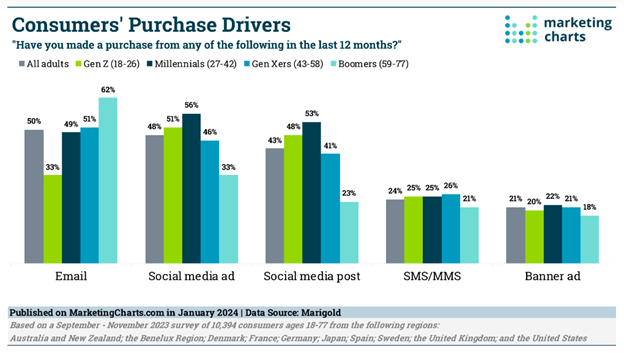Email continues to be a top channel influencing consumer purchase decisions. However, social platforms are quickly catching up, especially with younger consumers.
In research by Marigold, more Millennials and Gen Xers are influenced to purchase by a social media ad or post compared to email.
The survey revealed that 56% of Millennials purchased from a social media ad and 53% from a social media post. This is compared to 49% of purchases being driven by email.
Likewise, 51% of Gen Z made a purchase from social media ads and 48% from a social media post, compared to only 33% being influenced by email.
In contrast, the research shows that older generations, Gen Xers and Boomers, are more likely to be driven to purchase from email.

(Image Source: Marketing Charts)
So, if both aren’t in your budget, you may be trying to decide where to allocate your resources: email or social media.
Both channels offer unique benefits and challenges, and understanding the differences between them is important for creating an effective marketing strategy.
Email Marketing vs Social Media: Which Channel is Right for You?
Let’s delve into a comparison of email and social media to help you determine which channel is best suited for your business needs.
Demographics
As the research above shows, younger generations tend to use social media compared to older generations who favor email.
Older generations, including Baby Boomers and Gen X, tend to favor email as a primary channel for brand engagement and shopping. They value the familiarity, reliability, and privacy of email, often opting for personalized offers, promotions, and product recommendations delivered directly to their inbox, enabling them to make informed purchasing decisions at their convenience.
Younger generations, such as Gen Z and Millennials, often prefer to engage with brands on social media platforms, utilizing them not only for social interaction but also for discovery and shopping experiences. These digital natives leverage the interactive and visually driven nature of platforms like Instagram, TikTok, and Snapchat to discover new brands, explore products, and engage with branded content through immersive experiences and influencer endorsements.
Reach and Audience Targeting
Email marketing allows for precise audience targeting based on demographics, behavior, and engagement metrics. With email, you have direct access to subscribers who have opted in to receive your messages, enabling you to tailor content to their specific interests.
On the other hand, social media offers a broader reach and the potential to connect with a larger audience. Social media platforms provide tools for targeting specific demographics and interests, but reaching your entire audience relies on factors such as algorithm changes and user engagement.
Engagement and Interaction
Email marketing often boasts higher engagement rates compared to social media. Emails are delivered directly to subscribers’ inboxes, offering a personalized and intimate communication channel. With well-crafted subject lines and compelling content, emails can drive clicks, conversions, and customer interactions.
Social media, on the other hand, fosters real-time interactions and conversations. It allows for immediate engagement through likes, comments, and shares, fostering community-building and brand advocacy. However, the fast-paced nature of social media can also lead to shorter attention spans and content saturation.
Content and Messaging
Email marketing provides ample space for detailed content, storytelling, and product promotions. Marketers can leverage various email formats, such as newsletters, product updates, and promotional campaigns, to deliver value and drive conversions.
Social media, on the contrary, requires concise and visually compelling content to capture users’ attention amidst a constant stream of updates. Visual content, such as images and videos, performs particularly well on social media platforms, where users consume content quickly and on the go.
Conversion and ROI
Email marketing often yields higher conversion rates and ROI compared to social media. With targeted messaging and personalized offers, emails have the potential to drive direct sales and customer loyalty. Additionally, email metrics such as open rates, click-through rates, and conversion rates provide valuable insights into campaign performance and ROI.
While social media excels at brand awareness and community engagement, measuring ROI can be more challenging due to indirect attribution and the varying objectives of social media campaigns.
4 Tips For Integrating Email Marketing and Social Media
Depending on your objectives, audience, and of course, budget, integrating email and social media marketing strategies can yield powerful synergies, allowing businesses to amplify their reach, engagement, and conversion rates across multiple touchpoints.
Here are several strategies to effectively integrate email and social media for better marketing outcomes:
1. Cross-Promotion and Content Consistency
Ensure consistency in messaging and branding across both channels by cross-promoting content.
Share highlights of your email campaigns on social media platforms, enticing followers to subscribe for exclusive content or special offers. Similarly, leverage social media to tease upcoming email content, generating anticipation and driving traffic to your email sign-up page.
2. Social Proof and User-Generated Content (UGC)
Harness the power of social proof and user-generated content to bolster your email marketing efforts.
Incorporate customer testimonials, reviews, and UGC from social media into your email campaigns to build trust and credibility with your audience. Encourage email subscribers to follow your brand on social media to participate in discussions, share experiences, and contribute their own content.
3. Exclusive Offers and Contests
Drive engagement and incentivize cross-channel interaction by offering exclusive promotions, discounts, or contests to your email subscribers and social media followers.
Encourage subscribers to follow your social media accounts for access to special offers or participate in contests that require engagement on both email and social media platforms, thereby expanding your reach and engagement.
4. Personalized Retargeting Campaigns
Implement personalized retargeting campaigns that leverage data from both email and social media interactions to re-engage users across channels.
For example, retarget website visitors who abandoned their carts with dynamic email reminders and follow-up ads on social media, providing them with tailored offers or recommendations based on their browsing history.
Conclusion
The most successful digital marketing strategies use the strengths of both channels, in ways that complement each other. Utilizing the strengths of each channel can help your business reach your audience more effectively, driving better engagement and results.





